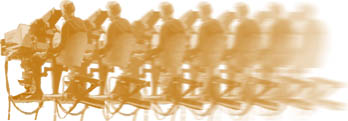
| "In the winter of 1956/7 colour transmissions were
originated live at AP in
the middle of the night and received by various brass hats. I was the vision mixer for a few months. We did two productions on alternate nights. One was a variety show featuring Elton Hayes , a well known singing guitarist, and dance routines by Gillian Lynn and Una Stubbs. The other production was a play called "The Revolver" a play based on story by an eminent Russian classic author - I forget who - with two or three actors. We had two colour cameras and a colour slide scanner. The cameramen were Maurice Fleischer and Tom Fawcett. The S.Tel.E was Tony Stanley and the engineers were Ken Howe, Eric Spain and Bill ?. The producers, directors and set designers were Barry Learoyd and Stewart Marshall. Make Up was by Maureen Winslade and costume by Olive ? These last four spent hours gazing at postage stamp sized colour samples on colour charts." |
|
"Gillian Lynn is now the mega famous choreographer who now does Broadway and West End
shows. In those days it actually used to snow in London! Some times the BBC bus could'nt get up the hill and we were stranded there. The engineers I spoke of were mad scientist types - one of them used to throw light bulbs about. I also remember being outraged when Tony Stanley made me solder some Jones plugs. I stupidly thought that we Tech Ops people were above that!" |
 |